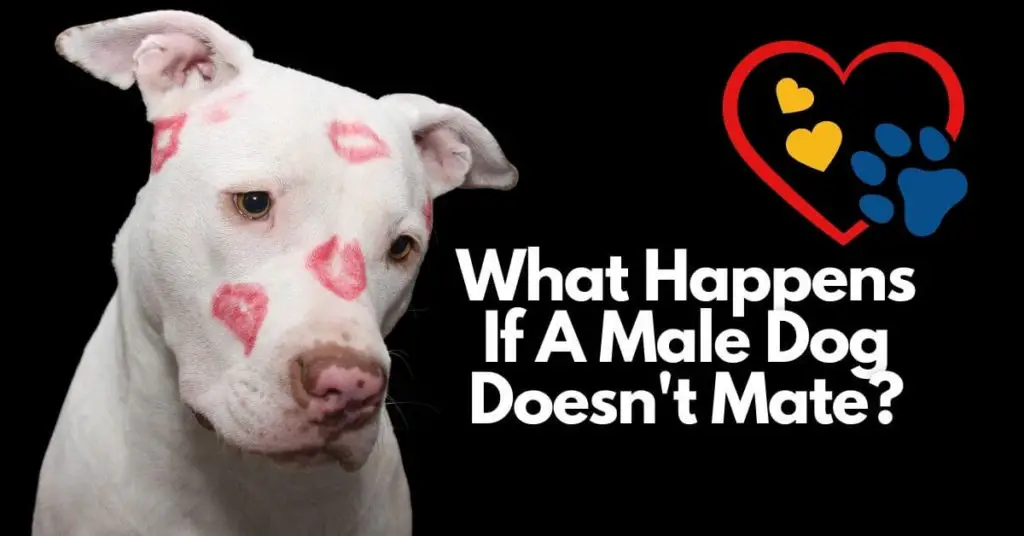There are various myths about a male dog’s ‘need’ to mate and the consequences of failing to mate. Such as, what happens if a male dog doesn’t mate? Will it develop cancer? Do you want to know if it’s true or just a myth?
If yes, then you’re at the right place.
In this article, you’ll learn:
- What happens if a male dog doesn’t mate?
- 13 Signs that a male dog wants to mate
- Do male dogs get cancer if they don’t mate?
- And more..

What Happens If A Male Dog Doesn’t Mate?
Like all other living beings designed for reproduction, your dog has an innate desire to mate. However, your dog’s life will not be harmed in any way if he does not mate. Mating is not necessary for your dog’s survival, and dogs can have normal, healthy, and long lives without mating.
If a male senses a female but is not allowed to approach her, he may get frustrated. However, your dog is not required to mate in order to live.
Animals, particularly dogs, have a stronger desire to reproduce. But if your dog does not mate, his life is not harmed.
You may be wondering about the loss of hormones that occurs when animals are fixed; will this harm your dog? If you’re concerned about these issues, talk to your veterinarian about getting your dog spayed or having a vasectomy.
Also, while dogs enjoy the act of reproducing (though some females do fear if a tie lasts too long), they do not mate for the sake of physical enjoyment. It is a genuine and natural instinct for dogs to mate in order to procreate.
If you choose not to neuter your dog, you may face problems of your dog wanting to mate when he grows up. Some common signs are excessive whining, humping almost everything and trying to escape and find a bitch in heat.
In short, dogs do not need to mate to survive, and they can certainly live without mating; however, a lack of sexual activity from the male may cause frustration. In contrast, not breeding a female dog can have both positive and negative health and hormonal effects.
My Male Dog Won’t Mate – What To Do?
According to Dr. Catherine Barnette, DVM from the VCA Hospital, a common behavioral cause of male dog infertility is the lack of dynamic between the male and female dogs resulting in a refusal to breed.
It is true that some male dogs will feel sexually frustrated if they do not get to mate. However, there are some cases when your dog may refuse to mate for a variety of other reasons. Some of them with their possible solutions are listed below:
1. Your Dog Is Neutered
Neutering or castration refers to the surgical removal of a dog’s testicles. The testicles are the body’s major sources of testosterone; therefore, removing them causes changes in a dog’s sex drive, hormone-related behaviors, and hormone-related health concerns.
Sexual behaviors, mating chances, and urine marking will all decrease after neutering.
Hence, if you’ve just adopted a dog who refuses to mate and you don’t know the dog’s history, it’s possible that he was neutered before. And neutered dogs have reduced testosterone levels, which means they will have less sex drive.
2. Your Dog May Be Bred Extensively In The Past
You may not have the full history of your dog’s life if he is an adopted dog. You may not have known that your dog has been bred more times than it prefers in its past life.
A dog who has been extensively bred in the past may develop a phobia of mating. The phobia or fear can be so bad that if it knows there is a female in heat nearby, your dog will start to whine, pace, and be nervous.
Reassure your dog whenever you notice changes in its behavior and try to keep it calm. Keep female dogs in heat away to reduce any stress on your dog. If you have both male and female dogs in your house, consider sending your male dog away to your relative or friend’s house during the period that your female dog is in season.
For more long term solutions, consult your vet to explore neutering options.
3. Your Dog Is Inexperienced or Just Not Interested
A variety of reasons might cause a male dog to be uninterested in mating with a female dog. It’s mainly due to a lack of experience on their part. Because he has no past experience with the female, a male dog ready to have his first coitus session may be unsure of what to do.
Also, the female dog might not be generating enough odors to entice the male. Some females do not emit the “proper” odor during the first few heat cycles.
Male dogs, when not interested, will ignore the signs given by female dogs. He might show some curiosity in the act by sniffing her and wandering around her, but he would not move or take part in mating.
This can be addressed by having the female examined to determine whether she is in full season or by having your male dog checked to see if he has a problem.
13 Signs That A Male Dog Wants To Mate
When your dog is ready and wants to mate, we guarantee that you will know it. Your dog will exhibit several obvious signs and changes in behavior to signal its intention.
Depending on whether you would like your dog to mate, it is important for you to take note of the following signs:
- Mounting/Humping: Sexually active canines are prone to mounting behavior. They will hump a number of things, including other canines and even people in their environment.
- Escaping: Many dogs will try to chase out a female dog if they sense that she is in heat. This can result in dogs becoming lost as a result of their attempts to escape.
- Destructiveness: Dogs can be easily distracted by their desire to mate, making it difficult for them to remain calm. They may become hyperactive as a result of their increased energy, running in circles, or doing anything they can to release their pent-up irritation.
- Becoming aggressive to other dogs: They may be more prone to bark at other dogs passing by your house or while out strolling with you.
- Marking: While dogs are territorial all year, a sexually mature dog will mark more frequently.
Besides the above-mentioned signs, some other signs might also indicate that a dog wants to mate; such as:
- Thrusting
- Clasping
- Ejaculating
- Playfulness
- Whining excessively
- Snapping at children
- Dominance over owners
- Showing curiosity in female’s vaginal secretions
What Happens If I Don’t Breed My Dog?
It’s fine if you don’t breed your dogs, but you should expect them to show signals of wanting to mate.
If you don’t want your dog to mate, having her sterilized as soon as possible is certainly a good idea, and the veterinarian is the best person to advise you on the ideal timing for this process.
Once your female dog is spayed or your male dog is neutered, unwanted dog pregnancies will be prevented, and their hormone levels drop, making them less interested in mating.
Does A Male Dog Need To Mate?
A male dog does not need to mate to survive. Unlike humans, dogs do not mate for pleasure, rather they mate for procreation purposes, although dogs do derive pleasure from mating too.
Instinctively, unneutered male dogs will want to mate if they sense a female dog in heat nearby. It has been said that male dogs can sense a female dog in heat as far as 3 miles away!
Male dogs are able to mate from as young as 4 months of age as long as they have viable sperms. According to the AKC, male dogs become fertile after 6 months of age and may reach full sexual maturity by 12 – 15 months. Adult male dogs are able to mate at any time and will remain sexually active and fertile to old age.
Hence, a dog doesn’t necessarily have to mate to live but it certainly is able to if it is not neutered.
How Often Do Male Dogs Need To Mate?
Male dogs can mate multiple times per day; however, they should not mate more than 1 or 2 times a day.
Male dogs, unlike female dogs, do not have a heat cycle and can mate at any time of the month or year. They can even successfully mate every day, which means they can mate up to 30 times per month, all year.
However, mating more than twice a day will lower the sperm quality of the dogs. And this will lead to lower chances of pregnancy in female dogs with whom the mating occurs.
If there are numerous females in heat, stud dogs can mate up to five times in one day. But remember that providing your dog the relaxation he requires is crucial.
It is also recommended that dogs take a day off between matings. It’s preferable to have them mate every other day so that the offspring are healthier, and this will keep sperm depletion and replenishment in check.
The longer the gap between breeding sessions, the better the dog, sperm, and offspring will be.
Do Male Dogs Get Cancer If They Don’t Mate?
There’s no considerable evidence as of now of male dogs getting cancer such as prostate cancer if they don’t mate.
Some research appears to suggest that neutering causes cancer, but when examined further, these studies mainly focus on relatively particular cases, making it difficult to put the study into context. It’s also essential to think about neutering time, which is rarely emphasized.
What Happens If A Female Dog Doesn’t Mate?
Female dogs don’t mate, a common mating problem. Try a different mate if your dog refuses to mate with one dog. In some cases, female dogs may not be interested in mating, and this occurs naturally in females as per their heat cycle.
It’s essential to remember that dogs who have been spayed or neutered can live just as long as dogs who haven’t been fixed.
Hence, if your female dog doesn’t mate, it’s perfectly normal and won’t cause any damage to her.
Also, if your female dog refuses to mate, it is entirely up to you as a dog owner. In terms of ethics, you should remember that your dog’s decision to mate is ultimately his or her own, and female dogs do not need to mate in order to survive.
If your dog refuses to mate, but you still want more puppies, consider adopting a dog from a shelter instead.

